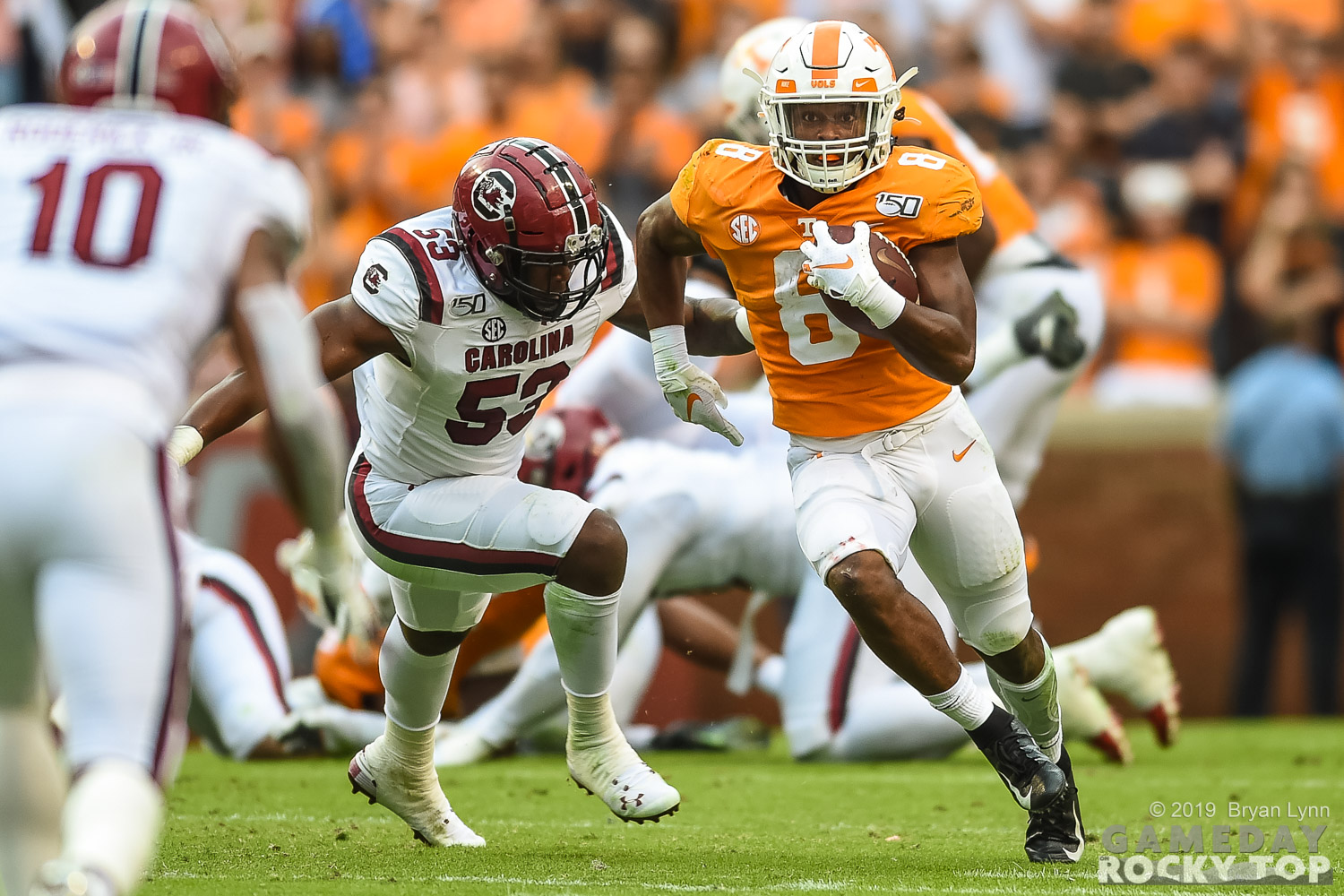1. Clemson
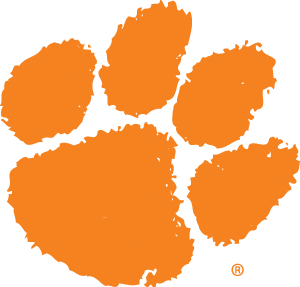
The 2018 National Champions nearly did it again last year but ran into a Bayou Buzzsaw wielded by Heisman Trophy-winner Joe Burrow in the 2019 championship game. Balance was the theme of the season for the Tigers with the offense putting up 529 yards per game and the defense holding opponents to only 288. The offense ranked No. 5 in the nation, and the defense ranked No. 6.
The Tigers this year aren’t so much re-loading as they are just pulling the trigger again. Three players – receiver Tee Higgins, linebacker Isaiah Simmons, and cornerback A.J. Terrell – left early for the NFL, and the offense loses four seniors along the offensive line, but most of the key components from last year’s near-national champions are back. Trevor Lawrence, Travis Etienne, and Justyn Ross will star in the offense, and most of the defensive line returns as well.
The biggest concern on the schedule is a Nov. 7 date with Notre Dame in South Bend. Expect the Tigers to roll through the ACC again this season right into the playoff.
2. Ohio State

The Buckeyes navigated the transition from Urban Meyer to Ryan Day just fine, thank you very much, following up a 13-1 season in 2018 with another one in 2019. They beat five ranked teams on their way to the College Football Playoff semifinal, where they lost a close one to Clemson. Like Clemson, Ohio State did it with balance: the nation’s No. 1 defense and No. 4 offense.
Chase Young and Jeff Okudah were both selected in the Top 3 picks of the NFL Draft, and J.K. Dobbins was picked No. 23, but there’s plenty of talent left behind. Justin Fields returns for another run at the Heisman with Master Teague III and Chris Olave in supporting roles. And the defense has talented guys ready to fill the voids left by Young and Okudah.
An early test in Eugene against the Oregon Ducks will set the tone, and they’ll have to contend with the regular minefield that is the Big 10 schedule, but the Buckeyes are positioned for the playoff again this year.
3. Alabama
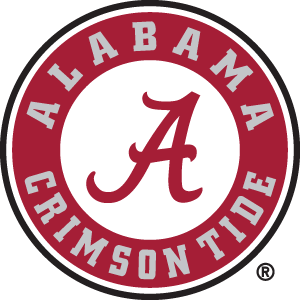
Alabama missed the playoff for the first time last fall but finished the season 11-2, the two losses coming to then-No. 2 LSU in the regular season by five points and then-No. 15 Auburn by three points.
As usual, the NFL has raided Alabama’s roster. Nine players from last year’s team were drafted, four of them in the first round. But running back Najee Harris returns, and the receiving corps gets DeVonta Smith and Jaylen Waddle back. Quarterback Mac Jones got a great deal of experience filling in for the injured Tua Tagovailoa last season, so he could take over again this fall, but he’ll also be challenged by elite prospect Bryce Young (GSEC6).
Alabama’s season kicks off with a game against Southern Cal, and the schedule also includes an early trip to Athens to take on a revenge-minded Georgia. They’ll also need to hold off SEC West opponents LSU, Auburn, and Texas A&M. That’s a ton of tough games, but don’t expect more than one of them to go sideways for the Tide.
4. Oklahoma
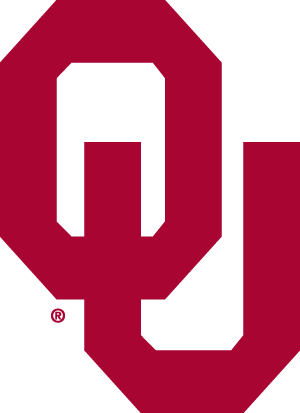
Oklahoma’s defense improved from No. 114 in the nation in 2018 to No. 38 last year under new defensive coordinator Alex Grinch. Meanwhile, Lincoln Riley’s offense just kept rolling on its way to a No. 3 national ranking, piling up 538 yards per game.
A perennial playoff participant, Oklahoma has a few additional holes to patch this fall. The offense was hardest hit with the graduation of Heisman Finalist Jalen Hurts and the early departure of receiver CeeDee Lamb to the NFL. Charleston Rambo will be ready to lead the receiving corps in the absence of Lamb, but Riley will likely have to entrust the offense to former 5-star prospect Spencer Rattler.
The defense will miss Kenneth Murray, Neville Gallimore, and Parnell Motley, but they’re in good shape and hoping to improve even more this fall under Grinch.
Assuming Riley does his thing with yet another new quarterback, expect the Sooners to contend for the national championship again this fall.
5. Florida

Florida has dramatically improved since Dan Mullen took over in 2018. After a 4-7 season in 2017, Mullen’s first team was 10-3, and they finished last season with an 11-2 record and a No. 6 national ranking. They’ve not been able to get past Georgia so far, though.
This could be the year.
Kyle Trask returns to the field for Florida this fall, and although the Gators’ offense loses receivers Van Jefferson, Freddie Swain, and Tyrie Cleveland, it returns pass-catching tight end Kyle Pitts and receiver Trevon Grimes. The defense will miss CJ Henderson, David Reese II, and Jonathan Greenard, but most other key pieces are back, including three different defensive backs with three interceptions each.
The Gators will need to improve the run game to increase their chances of jumping ahead of Georgia in the SEC East. But they were only one score apart last season, and this year they appear to be neck-and-neck. Expect the World’s Largest Outdoor Cocktail Party to decide the East this fall.
6. Georgia

Georgia’s defense was exceptional last season, but struggles on offense – and a historically good LSU team – deprived the Bulldogs of an invitation to the playoff.
This offseason, new offensive coordinator Todd Monken will have to deal with the departures of quarterback Jake Fromm, running back D’Andre Swift, and all but one starter along the offensive line. The team also has to find a replacement for Lou Groza Award-winning kicker Rodrigo Blankenship. But most of last year’s exceptional defense returns to the field this fall, including Monty Rice, Azeez Ojulari, and Richard LeCounte.
Things could prove more difficult for the Bulldogs this year with Florida nipping at their heels, Tennessee closing the gap, and Alabama rotating onto the cross-divisional schedule for a mid-September game. Depending on how those three contests go, the Bulldogs could roll right back to Atlanta for the fourth year in a row or they could end up finishing third in the SEC East.
7. Oregon
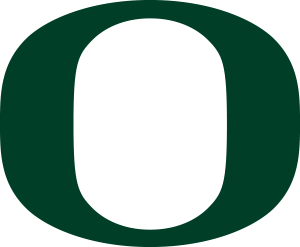
The Ducks had high hopes for the 2019 season, primarily because quarterback phenom Justin Herbert was returning along with one of the nation’s best offensive lines. Things didn’t go quite as planned. The team still finished 12-2 and ranked No. 5 in the nation, but the defense led the way.
Oregon returns a huge portion of that defense this fall, including literally everybody in the secondary, plus a couple of key linemen and linebacker Isaac Slade-Matautia, whose stat sheet looks like it’s just had Thanksgiving dinner.
The offense does need to replace Herbert and almost all of the offensive line, but the cupboard isn’t bare. CJ Verdell and Johnny Johnson III both return, as does All-American lineman Penei Sewell. And Joe Moorhead, former Mississippi State head coach and Penn State coordinator, takes the reins of the offense this fall for the Ducks.
Oregon trades last year’s game against Auburn for one against Ohio State this season. Regardless of how that one goes, the Ducks are in good shape for the Pac-12 title.
8. Penn State
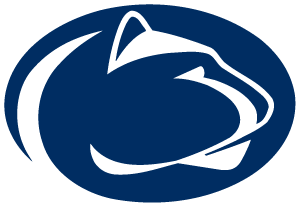
It wasn’t just Ohio State that dashed the dreams of Penn State last year, it was a surprising blow from then-No. 17 Minnesota under P.J. Fleck. So when Penn State lost offensive coordinator Ricky Rahne to Old Dominion, James Franklin went out and hired Gophers’ coordinator Kirk Ciarrocca, who’d been helping Fleck row the boat since 2017.
The Nittany Lions will have to contend with some early departures, including those of do-everything KJ Hamler and Yetur Gross-Matos, but they return a healthy amount of production from last year’s team, especially on offense. Quarterback Sean Clifford will miss Hamler, but can still count on the running back stable of Journey Brown, Noah Cain, and Devyn Ford running behind an offensive line that returns 80% of its starts.
The Buckeyes are still in the way, but stealing a coordinator from an up-and-coming rival and having most of a good roster back should have the Nittany Lions positioned to make another run at them this fall.
9. Wisconsin

Three of the Badgers’ four losses last season came to Oregon in the Rose Bowl and Ohio State twice on its way to the playoff. The team was limited by a woeful passing attack that couldn’t be saved by either an excellent defense or Jonathan Taylor running for over 2,000 yards for the second year in a row.
And now, Taylor is gone, as is Quintez Cephus and nearly half of last year’s receiving yards with him. Quarterback Jack Coan is going to have his hands full piloting an offense with such huge holes to fill.
Fortunately, the defense returns largely intact despite the losses of linebackers Zack Baun and Chris Orr. That’s because nearly all of the other key pieces are back, including everyone in the secondary and everybody on the line except for one reserve.
Unless one of Wisconsin’s running backs is ready to run for 2,000 yards this fall, the most reasonable expectation for the Badgers is a season pretty similar to last year’s.
10. Texas A&M
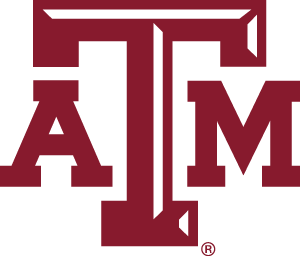
Jimbo Fisher’s second A&M team went 8-5, but those five losses were to LSU, Clemson, Alabama, Georgia, and Auburn.
The Aggies return much of their offense this fall, led by Kellen Mond, who threw for 2,897 yards and ran for another 500, and Isaiah Spiller, who added another 946 yards on the ground. The offense loses receivers Quartney Davis and Kendrick Rogers, but a solid pass-catching corps remains, led by Jhamon Ausbon. Plus, the offensive line returns 80% of its starts from last fall.
The defense loses a more significant amount of production from last year, the biggest losses being Justin Madubuike and Debione Renfro, but has plenty of talent remaining.
Most importantly, the Aggies trade last year’s game against Georgia for one against Vanderbilt and last season’s non-conference game against Clemson for one against Colorado. They still have Alabama, LSU, and Auburn to contend with, but the road’s a lot easier this year.
11. Notre Dame
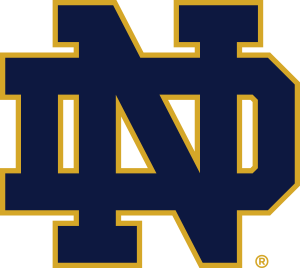
Notre Dame only lost twice in 2019, once to then-No. 3 Georgia and once to then-No. 19 Michigan. They did that with a Top 20 defense and an offense that somehow ranked in the Top 15 in points scored despite barely ranking inside the Top 50 in rushing, passing, and overall yards per game.
The offense returns quarterback Ian Book, but loses over 2,000 receiving yards with the departures of Chase Claypool, Chris Finke, and Cole Kmet.
On defense, Notre Dame must replace two draft picks in Julian Okwara and Khalid Kareem, plus Jamir Jones. The secondary will be without safety Alohi Gilman and cornerback Troy Pride Jr., but they’ve been recruiting well enough to have guys ready to step in to fill those spots.
The Fighting Irish host Clemson this fall and play Wisconsin at Lambeau Field in addition to appointments with Stanford and USC. Whether they can get past all of that and make it back to the playoff will depend largely on whether they can increase the offensive firepower.
12. Auburn
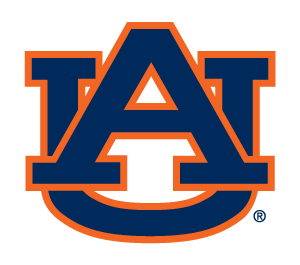
Auburn’s 9-4 record last year included losses to four ranked teams in Florida, Georgia, LSU, and Minnesota, and a win over Alabama.
New offensive coordinator Chad Morris will command an offense that returns Bo Nix and his top three targets from last season, led by receiver Seth Williams. The bad news is that they lose running back JaTarvious Whitlow and return only five out of 66 total starts along the offensive line.
There are a couple of huge holes on defense as well. Up front, they’ll miss All-American Derrick Brown and fellow lineman Marlon Davidson, and the secondary loses four players who started at least 12 games, including first-round draft pick Noah Igbinoghene.
The addition of Morris to the offense should help, but it’s tough in the ever-competitive SEC West, not to mention having Georgia as your permanent SEC East rival. If they make the most of their key games, the Tigers could finish well, but a new-look offensive line could make it difficult.
13. Texas

Tom Herman heads into 2020 with two new coordinators. On offense, it’s Mike Yurcich, most recently passing game coordinator at Ohio State, but prior to that coordinator at Oklahoma State from 2013-18. The new guy on defense is Chris Ash, who was head coach at Rutgers from 2016-19.
Texas ranks as one of the top teams in the nation in returning production, both on offense and on defense. Most importantly, Sam Ehlinger and running back Keaontay Ingram return for the offense. The receiving corps loses nearly 2,000 receiving yards with the departure of Devin Duvernay and Collin Johnson, but receiver Brennan Eagles returns to lead a still-solid unit. Joseph Ossai is back to lead the defense.
So much returning production, plus the fact that Texas is still recruiting like a national champion, could mitigate the learning curve associated with two new coordinators. They’ll need everything clicking to get past Oklahoma in the Big 12.
14. LSU

Last season was a magical one for Ed Orgeron, Joe Burrow, and the LSU Tigers. The team strung together a perfect 15-0 season capped by a decisive victory in a national championship game 90 minutes from campus.
But that was last year.
This year, only four college football teams rank lower in offensive returning production, and the Tigers’ defensive returning production isn’t much better. It’s not just Burrow, either. It’s Clyde Edwards-Helaire. It’s most of the offensive line and most of the linebackers. It’s Thorpe Award-winner Grant Delpit, and it’s both coordinators.
There is plenty of talent left on the roster to mitigate such catastrophic losses to some degree, however. Ja’Marr Chase returns to lead a still-star-studded receiving corps, and All-American defensive back Derek Stingley Jr. returns to lead a solid secondary.
But the Tigers will have a very difficult time duplicating what they did last year.
15. Oklahoma State

The Cowboys finished only 8-5 last season, but they return more overall production than anyone else except Georgia Tech.
Quarterback Spencer Sanders returns, as do five of his top six pass-catchers from last season, including Tylan Wallace. Most importantly, running back Chuba Hubbard returns as well. Hubbard ran for an eye-popping 2,094 yards and 21 touchdowns last fall.
As good as things are on the offensive side of the ball, things are even better on defense. They return nearly 90% of their starts in the secondary, all but one reserve player on the line, and the key pieces from last year’s linebacking unit, including Amen Ogbongbemiga, who had 100 tackles last season.
The Cowboys have road games at Oklahoma and Baylor ahead of them this fall, but they get Texas and Iowa State at home. With so much returning production, they could make things interesting in the Big 12 this fall.
16. Tennessee
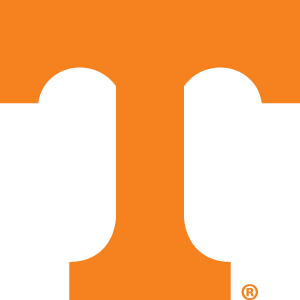
Tennessee went from receiving death threats in October to receiving votes in the final AP Poll in January, turning a catastrophic 1-4 start into a 7-1 finish for an 8-5 season.
This fall, they’ll have the same head coach, offensive coordinator, and defensive coordinator in consecutive years for the first time since 2014, plus an enviable amount of roster continuity to boot. On offense, the returning players include all of the quarterbacks, all of the running backs, and all of the starting offensive linemen, plus Georgia transfer Cade Mays, if he’s eligible. They do lose three pass-catchers from last fall, but Josh Palmer’s back to lead a still-talented unit. On defense, they return everybody on the line, all but one in the secondary, and all but two at linebacker.
With late-season momentum and coaching and roster continuity they haven’t had in a long time, look for Tennessee to not only maintain its lead over the second tier of the SEC East but also to make things much more interesting against Georgia and Florida this fall.
17. North Carolina
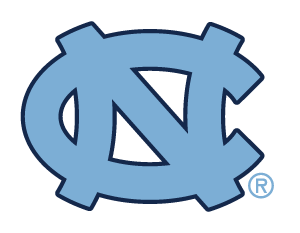
In his first year at Chapel Hill, Mack Brown led a Tar Heels team that had been 5-18 the two prior years to a 7-6 record that included a one-point loss to Clemson. The offense ended up No. 12 in the nation in total yards.
Almost all of that offense returns for Brown’s second act. His leading characters include quarterback Sam Howell, the team’s two leading rushers in Michael Carter and Javonte Williams, and seven of the team’s best pass-catchers. And the offensive line returns 50 of 65 starts.
The news is not quite as good on the defensive side of the ball. They lose two starting linemen, including fifth-round draft pick Jason Strowbridge, but they return most of the secondary and a solid linebacking corps led by Chazz Surratt and Jeremiah Gemmel.
Regardless of how an early test against a good Auburn team in the second game of the season turns out, expect further improvement from the Tar Heels this fall.
18. Southern California
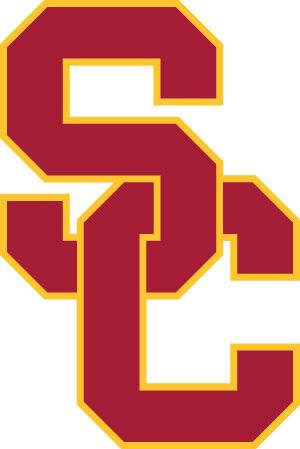
Coming off an 8-5 season, USC returns the third-most overall production in the nation. On offense, all of the Trojans’ passing yards are back, as are 99% of their rushing yards, most of their receiving yards, and a majority of their offensive line starts. They also return huge percentages of last year’s productivity on defense.
Quarterback Kedon Slovis returns to command the offense after throwing for 3,502 yards and 30 touchdowns last fall. He’ll miss Michael Pittman, an early second-round draft pick who piled up 1,275 receiving yards last fall, but a still-solid group remains, led by Amon-Ra St. Brown and Tyler Vaughns. And the entire herd of running backs returns looking to get on track behind an offensive line returning three starters. On defense, everybody’s back but lineman Christian Rector and ‘backer John Houston Jr.
With so much of last year’s roster returning, just getting the defense and running game going will go a long way toward getting the Trojans in the mix for the Pac-12 title.
19. Utah
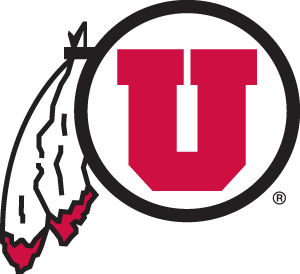
Last year, the Utes won their second consecutive Pac-12 South title on the strength of the nation’s No. 2 overall defense. They were so good on that side of the ball that the NFL came and stole it all.
In all, six defensive players were drafted and another left early but wasn’t picked. The losses include Bradlee Anae, Leki Fotu, John Penisini, Jaylon Johnson, Terrell Burgess, Julian Blackmon, and Javelin K. Guidry. That pretty much leaves Mika Tafua and Davin Lloyd to lead an entirely new unit.
The offense didn’t escape the raid, either, as running back Zack Moss was drafted as well. And what the NFL didn’t get, graduation did, as quarterback Tyler Huntley is out of eligibility. He’ll be replaced by either Cameron Rising, who transferred from Texas in 2018, or Jake Bentley, a graduate transfer who started 33 games at South Carolina.
That’s a lot of roster attrition to overcome, but Kyle Whittingham didn’t just luck into seven draft picks. He made it happen, and he’s probably cycling up to do it again.
20. Minnesota

Minnesota merrily rowed all the way to an 11-2 record last fall, losing only to Top 15 teams Iowa and Wisconsin and beating Auburn in the Outback Bowl. The defense was special – ranking No. 10 in the nation – and the offense was good enough to get them to a first-place finish in the Big 10 West and a No. 10 ranking in the final AP Poll.
Now the Gophers have to figure out how to do it after losing a significant amount of production, especially on defense. Four players on that side of the ball were drafted, including All-American defensive back Antoine Winfield Jr.
The offense loses receiver Tyler Johnson and running back Rodney Smith, but returns quarterback Tanner Morgan, receiver Rashod Bateman, and all of the offensive linemen.
The schedule doesn’t seem too daunting for the Gophers. They travel to Madison to take on Wisconsin, but get Michigan and Iowa at home. If they can shore up the losses, particularly on defense, they could do as well or better than last year.
21. Michigan

With rival Ohio State breaking in a new coach and the Wolverines returning most of their key pieces last year, Michigan looked ready to take control of the Big 10. They only lost four games, and all of them to ranked teams, but the missed opportunity had to sting.
And now, the window of opportunity looks to be closing again, as Michigan returns very little production from either the offense or the defense this fall. Shea Patterson has graduated, and ten players were drafted, three of whom left early.
Joe Milton and Dylan McCaffrey will battle to replace Patterson at quarterback. Whoever wins will have help from running backs Zach Charbonnet and Hassan Haskins and receivers Ronnie Bell and Nico Collins. Linebacker Cameron McGrone and defensive back Ambry Thomas will have the responsibility of getting the defense ready.
The Wolverines will have their opportunities again this season against Ohio State and others. They just need to take advantage of them.
22. Cincinnati
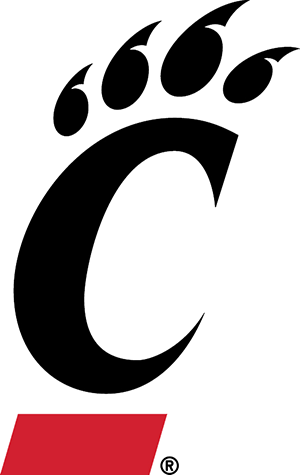
Cincinnati’s 11-3 record in 2019 included two losses to conference rival Memphis and a non-conference loss to Ohio State. The Bearcats’ offense wasn’t really up to the task, but a Top 40 defense helped them achieve a No. 21 ranking in the final AP Poll.
This year, the defense loses linebackers Bryan Wright and Perry Young, but gets all of its starters on the defensive line and most of its key guys in the secondary back.
The offense will be looking for improvement, and returns three key pieces to try to make that happen. Quarterback Desmond Ridder had 2,164 yards and 18 touchdowns passing and 650 yards and 5 touchdowns rushing last year. He’ll have his leading receiver Alec Pierce back with him as well this fall. They’ll miss 1,000-yard rusher Michael Warren II, but Gerrid Doaks looks to pick up the slack.
The Bearcats travel to UCF this fall but get both Memphis and Houston at home. If the offense can find a groove, they’ll have a shot at revenge with Memphis this fall.
23. Kentucky

Kentucky posted an 8-5 record without a true quarterback last season. This year, Terry Wilson returns, but he may have to fight off Auburn transfer Joey Gatewood to win back the job. Whoever lines up under center will have nearly 2,000 yards of returning rushing yards to lean on and 80% of the offensive line back. The team’s Top 25 defense loses a key piece at each level but remains a mostly solid group. If they get things worked out in the passing game, they could make some noise in the SEC East.
24. Boise State
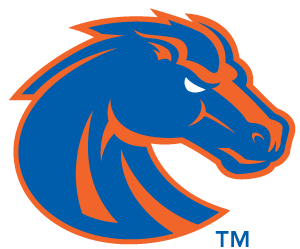
Bryan Harsin and the Broncos are poised to make it three out of the last four Mountain West titles thanks largely to the return of quarterback Hank Bachmeier and 1,000-yard rusher George Holani, both of whom earned their stripes as freshmen last year. The team does have significant concerns along the line of scrimmage, however, as most of the starters on both sides have departed, including edge rusher Curtis Weaver. Boise State will get a chance to shine when Florida State comes to town the third week of the season.
25. UCF
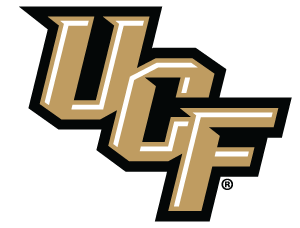
UCF looks to get back to the top of the American Athletic after finishing second to Cincinnati last fall. This year, the nation’s No. 2 offense returns quarterback Dillon Gabriel, who threw for 3,653 yards and 29 touchdowns as a freshman last season. McKenzie Milton, who missed all of last season with a serious leg injury, may be ready to compete for the position again as well. Eight starters return on defense, including most of the secondary. Hosting Cincinnati late may decide the season for the Knights.
